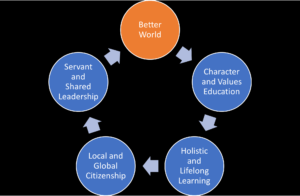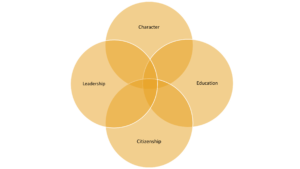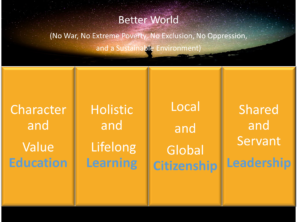“To begin with the end in mind means to start with a clear understanding of your destination.”
Steven Covey
The End in Mind: A Better World for All
I’ve attempted to frame the conversation around the substantial work that has been done in the last 75 years through organizations like the UN, UNESCO, the World Bank and dozens of others. Yet, with all these outstanding efforts, we still have a world fraught with challenges. Extreme poverty, war, exclusion, oppression still exist, and we now have a planet whose human environment is threatened more than ever before. But, it doesn’t have to be this way. We have the capability to eliminate each of these problems and create our “Utopia” for today. What is needed is a global commitment to a shared purpose.
Begin with Purpose
Without knowing our destination, how can we design learning? I have found many organizations that are striving to create a better world who see education as the critical component of the solution. It’s inspiring to know that so many people want a better world but are we in agreement on what that world might look like? I’ve had many conversations about what a better world means, and opinions vary widely. This becomes problematic because if we don’t have consensus on the destination, how will we get there? Consequently, we need clarity on the destination and with that in place we can have our policy makers, corporations, our schools, and subsequently our students begin with the “end in mind.” We can then design the best strategy and course to reach that destination purposefully.
So, let’s be bold and propose a destination. Let’s answer that question, what is a better world? Of course, placing ten people in a room will likely produce ten different answers. To minimize the discussion and debate, I am proposing that we focus on those issues that are widespread and have been with us since civilization began. The list of challenges that we will discuss are war, poverty, exclusion, oppression, and sustainability (as sighted by the Delor’s Commission (see my blog, Creating a Better World) and aligned with the UN Sustainable Development Goals SDG’s), and thus our destination is the eradication of the first four, and the development of the last. If we were to succeed, I don’t think there is a person on the planet that would not agree we have created a substantially better world, and one that most likely resembles a true human ideal. To lead humanity toward a vision of a world without war, poverty, oppression, exclusion will give us great purpose and meaning that each human being can contribute and strive toward. It would change the conversation from talking about 21st century skills, to positioning humanity for the next millennium and beyond. If we do not begin this process soon, the 21st century may be the last we need to prepare for.
In education, especially for those whose mission is to create a better world, we have avoided defining that world. We develop students with the assumption and “hope” they will create a better world without providing any direction or purpose. Knowing where we are going gives us a destination, and eradicating war, poverty, oppression, exclusion would be world changing and impact billions of lives for generations to come. They evoke a tremendous need for each of us to show genuine caring and kindness toward our fellow person. Setting this as our goal would give us great purpose and meaning, and this purpose at the macro level will be a catalyst for purpose at the individual level. A common purpose becomes the driver of individual purposes, and we can then create an education model to nurture and educate people at the youngest of age and throughout their life to strive for a better world in all they do.
Joel Katzman in his book “Common Purpose” says that “common purpose is a force you can almost feel.” Perhaps you’ve worked for an organization or been part of a team that had a common purpose with a clear destination in mind. Think of the most successful entities, and you will conclude that each were driven by a goal and purpose that allowed them to overcome the most challenging obstacles. It is the same for humanity, albeit on a substantially larger scale, and if we don’t define and embrace our purpose, we will be educating our children as we have always been without a clear direction of where we are going. Howard Gardner puts it well. “the world will not be saved by high test scores. . . What is needed more than ever is a laser-like focus on the kinds of human beings that we are raising and the kinds of societies that we are fashioning.” I have put forth a starting point for the kind of society we need to fashion. We can only imagine the amount of needless suffering that will end when we get there.
A Theory of Change for a better world
A better world cannot happen on its own. Destinations are rarely reached without a strategy or plan. Up to this point, we have put great hope in our education systems, organizations like the UN and World Bank, and leaders around the world to get us there, and yet a better world as defined continues to elude us, and in many respects moves further away. Hope, although enormously powerful, is not a strategy on its own. At this point, we need to develop a way to a better world that is comprehensive, flexible enough to be easily implemented, accessible to all, and one that allows for continuous improvement. This last part is important to understand because a better world for us today, will become the new normal for a future generation, who will then design their own better world.
I believe that we are poised to make a leap in our humanity, but we need a world dedicated at all levels, across all cultures, and at all ages to achieving a better world for all people. To do this, we need to have greater purpose in our education and learning with people who are of good character with sound values. We need to educate the whole person throughout life, and have people understand their individual role and value to the human community and our shared purpose. Finally, we need each person to understand that with shared purpose comes shared responsibility and the need to share in leadership as a service to each other.
None of these concepts are new, but what is missing is a purpose driven approach that is comprehensive and connects and integrates these toward the objective of the creation of a better world. A Theory of Change for a better world is structured to infuse purpose into the education and learning process. It starts with purpose (i.e. a better world) and is designed to create a greater connection between the purpose of creating a better world with how we educate ourselves and how we learn.

Theory of Change for a Better World
Four Interconnected and Interdependent Domains
The approach emphasizes four interconnected and interdependent domains:
- Character and Values Education
- Holistic and Lifelong Learning
- Local and Global Citizenship
- Shared and Servant Leadership.
- Starting with the shared purpose of creating a Better World; one without war, poverty, oppression, exclusion, and with a sustainable planet, we need
- Good People developed through Character and Values Based Education.
- An Education of the whole person to unlock the full potential of each human being, and this must be a continual lifelong process.
- Development of an understanding of citizenship, local and global, and the shared nature of our purpose to create a better world for all.
- Finally, with shared purpose comes shared responsibility, and thus the need for each of us to serve and share in leadership toward a better world.
 A Path Toward a Better World
A Path Toward a Better WorldYou may note that each of these independently is nothing new. There are many outstanding organizations doing outstanding work in each area. However, what is missing is a comprehensive approach. Global citizenship alone will not do it. Character education alone will not do it. Holistic learning by itself won’t do it. And, the right leadership by itself will not be enough. All of these, taken together and working in support of each other, is crucial in creating a better world.
 Interconnected and Interdependent Domains
Interconnected and Interdependent Domains
More importantly, it has to be owned by each and every one of us. A better world for all is a lifelong commitment, no matter how small the contribution. We each need to be devoted learners for life because things will change constantly and continually.

Learning Framework for a Better World
CONCLUSION
We need to get serious about where we are going, and we need a plan to get there. I’ve put forth a Theory of Change that includes four pillars. As pointed out, none of these are new as independent areas for consideration, but they need to be acted upon in a comprehensive and unified manner. Each of the domains themselves will not be enough to get us there, but together they can.
In the following blogs, I’ll delve more deeply into each pillar showing their individual relevance and importance, but more importantly showing discussing them as a comprehensive and integrated framework to achieve continual improvement and lasting change. After all, we’re not just looking toward our own utopia; we’re setting up future generations to develop their own.

